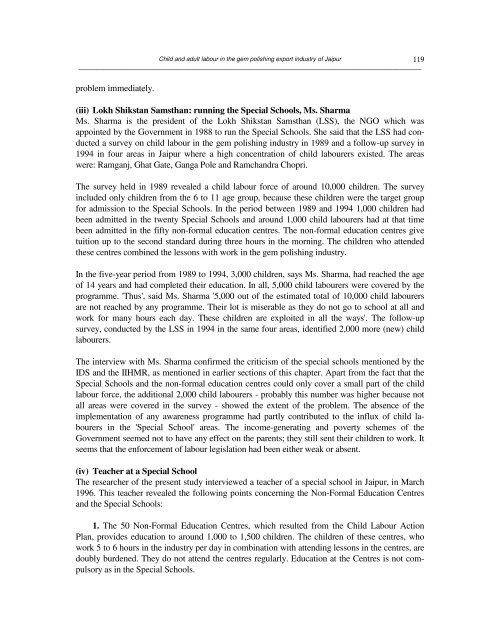You also want an ePaper? Increase the reach of your titles
YUMPU automatically turns print PDFs into web optimized ePapers that Google loves.
<strong>Child</strong> <strong>and</strong> <strong>adult</strong> <strong>labour</strong> <strong>in</strong> <strong>the</strong> <strong>gem</strong> polish<strong>in</strong>g <strong>export</strong> <strong>in</strong>dustry <strong>of</strong> Jaipur<br />
──────────────────────────────────────────────────────────────────────────────────────────────<br />
problem immediately.<br />
(iii) Lokh Shikstan Samsthan: runn<strong>in</strong>g <strong>the</strong> Special Schools, Ms. Sharma<br />
Ms. Sharma is <strong>the</strong> president <strong>of</strong> <strong>the</strong> Lokh Shikstan Samsthan (LSS), <strong>the</strong> NGO which was<br />
appo<strong>in</strong>ted by <strong>the</strong> Government <strong>in</strong> 1988 to run <strong>the</strong> Special Schools. She said that <strong>the</strong> LSS had conducted<br />
a survey on child <strong>labour</strong> <strong>in</strong> <strong>the</strong> <strong>gem</strong> polish<strong>in</strong>g <strong>in</strong>dustry <strong>in</strong> 1989 <strong>and</strong> a follow-up survey <strong>in</strong><br />
1994 <strong>in</strong> four areas <strong>in</strong> Jaipur where a high concentration <strong>of</strong> child <strong>labour</strong>ers existed. The areas<br />
were: Ramganj, Ghat Gate, Ganga Pole <strong>and</strong> Ramch<strong>and</strong>ra Chopri.<br />
The survey held <strong>in</strong> 1989 revealed a child <strong>labour</strong> force <strong>of</strong> around 10,000 children. The survey<br />
<strong>in</strong>cluded only children from <strong>the</strong> 6 to 11 age group, because <strong>the</strong>se children were <strong>the</strong> target group<br />
for admission to <strong>the</strong> Special Schools. In <strong>the</strong> period between 1989 <strong>and</strong> 1994 1,000 children had<br />
been admitted <strong>in</strong> <strong>the</strong> twenty Special Schools <strong>and</strong> around 1,000 child <strong>labour</strong>ers had at that time<br />
been admitted <strong>in</strong> <strong>the</strong> fifty non-formal education centres. The non-formal education centres give<br />
tuition up to <strong>the</strong> second st<strong>and</strong>ard dur<strong>in</strong>g three hours <strong>in</strong> <strong>the</strong> morn<strong>in</strong>g. The children who attended<br />
<strong>the</strong>se centres comb<strong>in</strong>ed <strong>the</strong> lessons with work <strong>in</strong> <strong>the</strong> <strong>gem</strong> polish<strong>in</strong>g <strong>in</strong>dustry.<br />
In <strong>the</strong> five-year period from 1989 to 1994, 3,000 children, says Ms. Sharma, had reached <strong>the</strong> age<br />
<strong>of</strong> 14 years <strong>and</strong> had completed <strong>the</strong>ir education. In all, 5,000 child <strong>labour</strong>ers were covered by <strong>the</strong><br />
programme. 'Thus', said Ms. Sharma '5,000 out <strong>of</strong> <strong>the</strong> estimated total <strong>of</strong> 10,000 child <strong>labour</strong>ers<br />
are not reached by any programme. Their lot is miserable as <strong>the</strong>y do not go to school at all <strong>and</strong><br />
work for many hours each day. These children are exploited <strong>in</strong> all <strong>the</strong> ways'. The follow-up<br />
survey, conducted by <strong>the</strong> LSS <strong>in</strong> 1994 <strong>in</strong> <strong>the</strong> same four areas, identified 2,000 more (new) child<br />
<strong>labour</strong>ers.<br />
The <strong>in</strong>terview with Ms. Sharma confirmed <strong>the</strong> criticism <strong>of</strong> <strong>the</strong> special schools mentioned by <strong>the</strong><br />
IDS <strong>and</strong> <strong>the</strong> IIHMR, as mentioned <strong>in</strong> earlier sections <strong>of</strong> this chapter. Apart from <strong>the</strong> fact that <strong>the</strong><br />
Special Schools <strong>and</strong> <strong>the</strong> non-formal education centres could only cover a small part <strong>of</strong> <strong>the</strong> child<br />
<strong>labour</strong> force, <strong>the</strong> additional 2,000 child <strong>labour</strong>ers - probably this number was higher because not<br />
all areas were covered <strong>in</strong> <strong>the</strong> survey - showed <strong>the</strong> extent <strong>of</strong> <strong>the</strong> problem. The absence <strong>of</strong> <strong>the</strong><br />
implementation <strong>of</strong> any awareness programme had partly contributed to <strong>the</strong> <strong>in</strong>flux <strong>of</strong> child <strong>labour</strong>ers<br />
<strong>in</strong> <strong>the</strong> 'Special School' areas. The <strong>in</strong>come-generat<strong>in</strong>g <strong>and</strong> poverty schemes <strong>of</strong> <strong>the</strong><br />
Government seemed not to have any effect on <strong>the</strong> parents; <strong>the</strong>y still sent <strong>the</strong>ir children to work. It<br />
seems that <strong>the</strong> enforcement <strong>of</strong> <strong>labour</strong> legislation had been ei<strong>the</strong>r weak or absent.<br />
(iv) Teacher at a Special School<br />
The researcher <strong>of</strong> <strong>the</strong> present study <strong>in</strong>terviewed a teacher <strong>of</strong> a special school <strong>in</strong> Jaipur, <strong>in</strong> March<br />
1996. This teacher revealed <strong>the</strong> follow<strong>in</strong>g po<strong>in</strong>ts concern<strong>in</strong>g <strong>the</strong> Non-Formal Education Centres<br />
<strong>and</strong> <strong>the</strong> Special Schools:<br />
1. The 50 Non-Formal Education Centres, which resulted from <strong>the</strong> <strong>Child</strong> Labour Action<br />
Plan, provides education to around 1,000 to 1,500 children. The children <strong>of</strong> <strong>the</strong>se centres, who<br />
work 5 to 6 hours <strong>in</strong> <strong>the</strong> <strong>in</strong>dustry per day <strong>in</strong> comb<strong>in</strong>ation with attend<strong>in</strong>g lessons <strong>in</strong> <strong>the</strong> centres, are<br />
doubly burdened. They do not attend <strong>the</strong> centres regularly. Education at <strong>the</strong> Centres is not compulsory<br />
as <strong>in</strong> <strong>the</strong> Special Schools.<br />
119


















